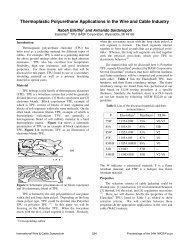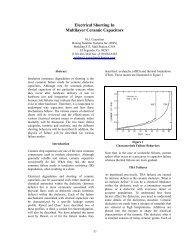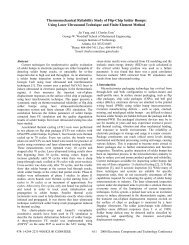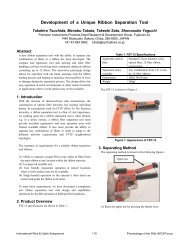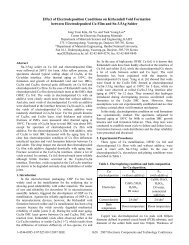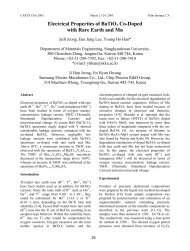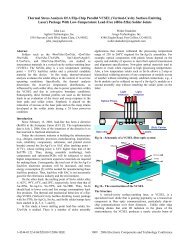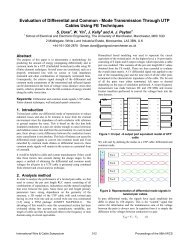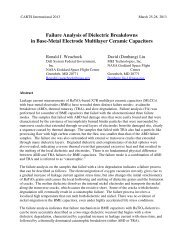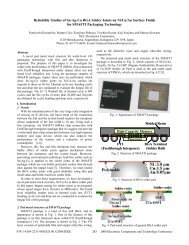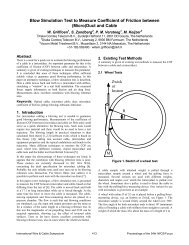Lead-Free Glass Formulations for Passive Component Termination
Lead-Free Glass Formulations for Passive Component Termination
Lead-Free Glass Formulations for Passive Component Termination
You also want an ePaper? Increase the reach of your titles
YUMPU automatically turns print PDFs into web optimized ePapers that Google loves.
CARTS USA 2006 April 3-6, 2006 Orlando, FL<strong>Lead</strong>-<strong>Free</strong> <strong>Glass</strong> <strong>Formulations</strong> <strong>for</strong> <strong>Passive</strong> <strong>Component</strong><strong>Termination</strong>Matthew Bogart and Harlan BrownVIOX Corporation6701 Sixth Avenue South, Seattle, WA 98108, USATel: 1-206-763-2170, Fax: 1-206-763-2577Email: mbogart@viox.com and/or hbrown@viox.comABSTRACTVIOX Corporation, a leading manufacturer of electronic and specialty glass materials,manufactures glass additives <strong>for</strong> active/passive component termination pastes and dielectricsintering aids. These glasses have been <strong>for</strong>mulated <strong>for</strong> lead-free, RoHS compliantapplications and can be used in silver or copper termination systems. <strong>Formulations</strong> weredesigned <strong>for</strong> air or nitrogen termination firing atmospheres.<strong>Glass</strong> compositions are bismuth-based <strong>for</strong> air applications and silicate-based <strong>for</strong> BMEatmospheres. The lead-free, bismuth-based <strong>for</strong>mulations are derived from the VIOXCorporation 19504 and V0981 <strong>for</strong>mulations. Several glass science principles <strong>for</strong> replacingPbO in the VIOX Corporation <strong>for</strong>mulations were investigated and include the addition ofhigh mobility ions, highly polarizable/de<strong>for</strong>mable ions, and varied ionic size glass-modifiers.These principles permit the substitution of PbO to decrease mass-transport properties andenhance glass flow characteristics. The results of these compositional substitutions will bediscussed with corresponding properties provided <strong>for</strong> the lead-free <strong>for</strong>mulation derivatives.<strong>Lead</strong>-free glass flow temperatures range from 550°C to 850°C.The silicate glass systems are derived from the VIOX Corporation V1560 <strong>for</strong>mulations.Composition derivatives were designed to enhance plating solution durability <strong>for</strong> terminationapplications and improve bonding in BaO and SrO-based dielectric systems.INTRODUCTIONVIOX Corporation, a leading manufacturer of electronic and specialty glass powders andfrits, receives numerous product inquiries <strong>for</strong> low temperature glass <strong>for</strong>mulations that requireRestriction of Hazardous Substances (RoHS) compliance. VIOX Corporation hasmanufactured glasses containing CdO and PbO <strong>for</strong> the past decade and has recently increasedits development focus on expanding the RoHS compliant glass options <strong>for</strong> a diverseapplication field. Applications <strong>for</strong> these products include glass-to-metal sealants, metal pasteadditives, termination materials <strong>for</strong> active and passive components, and solar cells. Many ofthese technical applications require the glass to demonstrate bulk flow 550°C-850°C andprovide chemical consistency.
VIOX Corporation glass <strong>for</strong>mulations 19504 and V0981 provide desirable low temperatureglass characteristics, but are not RoHS compliant. The corporate development group hastaken these marketed glass <strong>for</strong>mulations and derived numerous PbO-free <strong>for</strong>mulations toreplace the non-compliant compositions and accommodate the current environmentaldemands.The present paper describes the PbO-free <strong>for</strong>mulation development investigation <strong>for</strong> the19504 and V0981 glasses. <strong>Glass</strong> science principles critical in the successful development oflow temperature compositions are utilized to meet the targeted glass thermal characteristicsand glass flow properties.In addition to heavy-metal containing compositions, silicate-based glass <strong>for</strong>mulations weremodified to enhance plating durability and improve bonding to various dielectrics. TheV1560 glass is RoHS compliant and compositions were designed to increase acid resistanceand improve bonding to a strontium-based dielectric system.BACKGROUND<strong>Lead</strong>ed glasses have long been utilized in the manufacture of low temperature glasses. Theaddition of PbO in glass <strong>for</strong>mulations offers a number of properties difficult to duplicatewithout using a lead constituent. Literature [1-4] notes numerous properties of leaded glassesthat make these glasses useful in a variety of applications. Some of the desirable properties oflead in silicate glasses include the constituent’s fluxing capabilities and low temperaturemelting, wide working range, high electrical resistivity, ability to absorb gamma radiation,high refractive index, and the lowering of the glass surface tension that can enhance the glasswetting and bonding to oxide ceramics. These properties provide leaded glass use in a widevarietyof applications including solder and sealing glasses, enamels, glazes, radiationshielding glasses, and numerous electronic applications.The <strong>for</strong>mation of glasses without the PbO constituent offers RoHS compliant <strong>for</strong>mulations <strong>for</strong>numerous electronic applications where high flow, low temperatures, and optimized wettingand bonding is desired. The design of lead-free <strong>for</strong>mulations can result in similar thermalproperties; however, it is evident that lead-free <strong>for</strong>mulations present a number ofcomplications versus the leaded compositions. <strong>Lead</strong>-free <strong>for</strong>mulations tend to have a smallworking range, resulting in many more <strong>for</strong>mulations being designed to target very specificapplication temperatures. Wetting and bonding is less ideal in the lead-free <strong>for</strong>mulations dueto the increased surface tension of the glasses. Other observed differences in lead-free glasscompositions include tighter firing temperature ranges, a greater tendency <strong>for</strong> crystallization,and a less <strong>for</strong>giving behavior upon re-firing of glass seals and substrates.The primary objective of the RoHS directive is to prevent hazardous materials from enteringlandfill sites. RoHS directives restrict six substances in the use of electrical and electronicequipment. The restricted substances include lead and cadmium, as well as hexavalentchromium, polybrominated biphenyl flame retardants, and polybrominated biphenyl etherflame retardants [5]. There are a number of RoHS exemptions that permit the use of lead inhigh melting point solders and electronic ceramic parts. Exemptions also permit the use ofcadmium in certain plating processes. While exemptions exist, eliminating the hazardousconstituents in the glass powders removes the liability from the manufacturer. This permitsall manufacturing facilities and organizations involved to provide environment-friendly endproducts.
EXPERIMENTAL PROCEDUREVIOX Corporation’s 19504 and V0981 glass <strong>for</strong>mulations were selected <strong>for</strong> re<strong>for</strong>mulation toaccommodate RoHS compliance regulations. Constituents added to enhance the masstransportproperties of the PbO-free <strong>for</strong>mulations included alkali, alkaline-earth, and heavymetals to assist in reducing the glass microstructural rigidity. A third <strong>for</strong>mulation, V1560,was selected <strong>for</strong> durability and bonding property adjustment by varying the glass thermalproperties. The V1560 glass modifications focused on increasing the connectivity of theglass microstructure to reduce ionic diffusion in acidic mediums. The targeted 19504, V0981,and V1560 glass properties with the corresponding PbO concentrations are presented in TableI. All of these base glass compositions have been used as termination materials <strong>for</strong> passiveand active electronic components.FormulationIDDensity(g/cc)LabinoSP (°C)CTE(x10 -7 /°C)Tg (°C) Ts (°C) Tf (°C) PbO (mol%)19504 6.99 450 102.8 393 417 650 5V0981 5.26 474 87.2 391 429 550 45V1560 3.35 575 81.0 501 544 700 0Table I. Base-glass <strong>for</strong>mulation properties targeted <strong>for</strong> RoHScompliant <strong>for</strong>mulation derivatives and property modification. Tf is theflow temperature at which bulk glass flow is evident with no observedgranulation remaining from the glass powder.The 19504 <strong>for</strong>mulation was designed as a silver termination glass <strong>for</strong> capacitors and activeelectronic components. The 19504 is a CdO-free composition that offers similar propertiesand has been established by VIOX Corporation as a direct alternative to the 19911<strong>for</strong>mulation. The PbO-free 19504 <strong>for</strong>mulation alternatives included V2077-V2081. The PbOsubstitution was per<strong>for</strong>med on a 1:1 mole basis using composition normalization, alkalineearthmodifiers, and alkali + alkaline-earth modifiers. Further investigative work improvedthe low temperature characteristics of the PbO-free 19504 compositions.The V0981 PbO-free <strong>for</strong>mulation investigation was per<strong>for</strong>med in two phases. The first phasedesigned <strong>for</strong>mulations that substituted <strong>for</strong> the ~45 mol% PbO in the V0981 composition.This first phase <strong>for</strong>mulation studies designed V2082-V2088. The PbO substitution wasper<strong>for</strong>med on a 1:1 mole basis using alkali, alkaline-earth modifiers, heavy metalsubstitutions, oxide versus fluoride raw materials, and combinations of these glassmodifications. The second phase of the V0981 PbO-free <strong>for</strong>mulation design focused onreducing the measured CTE values of the most successful derivatives to date and to diversifythe end application. <strong>Formulations</strong> were modified by increasing the glass microstructureconnectivity with constituents that offer higher bond strengths and a greater ionic fieldstrength [1-2].The V1560 <strong>for</strong>mulation was designed as a BME termination glass. Improved chemicaldurability <strong>for</strong> plating operations had been requested and was pursued from a theoretical glassscience standpoint. The composition was modified by increasing the glass microstructureconnectivity by removing certain glass modifiers. The most mobile cations were reduced todecrease the ionic diffusion capability in the acidic medium. Since the V1560 composition
was designed as a BaO-based dielectric termination glass, a SrO-based termination glass wasderived to improve bonding characteristics <strong>for</strong> the different dielectric system.The PbO-free glass <strong>for</strong>mulation derivatives of 19504 and V0981 were batched using technicalgrade, high-purity raw materials. Similar high purity raw materials were used to batch allV1560 composition derivatives. Raw materials that demonstrate hygroscopic tendencieswere used as hydrated species to maintain chemical consistency. Raw materials used inbatching, melting, and all other processing includes the use of crystalline silica, hydratedalumina, hydrated granular boric acid, and other high purity carbonate and oxide materials.Melting of compositions was per<strong>for</strong>med in platinum crucibles in an electric furnace [Deltech;Denver, CO] using a 60 minute soak duration and oxygen bubbling <strong>for</strong> mixing andhomogenization. Melt temperatures began at 1000°C and were increased as required to reacha desired glass viscosity that would be functional <strong>for</strong> deionized water quenching.During the melting process, splat-cooled Labino [Harrop SP-3A] softening point sampleswere collected and buttons were poured <strong>for</strong> testing coefficient of thermal expansion (CTE),glass transition temperature (Tg), and dilatometric softening point (Ts) on the TMA [SeikoTMA 300]. <strong>Glass</strong> frit was dried using a <strong>for</strong>ced air, convection oven at 130°C [Lindberg Blue-M]. <strong>Glass</strong> melt density was tested [Micromeritics AccuPyc 1330] on the as-quenched glassfrit.The 19504 and V0981 derivative glass frits were ball-milled in porcelain mills using 13/16″alumina media and an organic dispersing agent. Milled particle sizes targeted a D 50 from 3-8μm, depending on the targeted application. Particle size analysis was tested using a laserparticle size analyzer [Malvern Mastersizer Micro-Plus] in a deionized water medium and anelectrolyte dispersant. <strong>Glass</strong> refractive index was selected to be representative of the glass<strong>for</strong>mulation in the specified test medium where n=1.3300. Dry-milled glass powder wasscreen -325 mesh be<strong>for</strong>e particle size testing and glass powder flow tests.The V1560 derivative glass frits were ball-milled in urethane mills using 1/2″ zirconia mediain deionized water. Milled particle sizes targeted a D 50 of 2.0 ± 0.5 μm and were tested in thesame manner as the bismuth-based glass compositions. <strong>Glass</strong> refractive index was selected tobe representative of the glass <strong>for</strong>mulation in the specified test medium where n=1.3300.<strong>Glass</strong> powder flow testing was per<strong>for</strong>med from 500-850°C, at 50°C temperature increments.Flow testing required
property relations. The investigative study focused on removal of the PbO constituents andappropriate substitutions to provide low temperature glass flow and thermal properties.The incorporation of alkali constituents into the RoHS compliant glass <strong>for</strong>mulations offers asimple method of decreasing thermal property measurements, but the electronic applicationscommonly pursue other alternatives to decrease the glass working temperatures. Decreasingthe glass connectivity can be accomplished by creation of non-bridging oxygen (NBO), wherethe addition of each alkali ion creates one NBO. The decrease in glass connectivity results ina decrease in glass viscosity and increase in thermal expansion coefficients [2]. In order toenhance chemical durability, a high degree of glass microstructural connectivity is targetedand generally mass-transport properties are more refractory when durability is improved.The addition of highly polarizable ions to a glass microstructure can correspond to the ionsize. For instance, silicate networks can manage high glass modifier content of PbO, Bi 2 O 3 ,and Tl 2 O [2]. The corresponding ions <strong>for</strong> these heavy metals are large in size and are shownto improve low temperature characteristics and glass flow properties. The increasing additionof PbO, Bi 2 O 3 , and Tl 2 O are documented to decrease viscosity, trans<strong>for</strong>mation temperatures,and softening temperatures [1]. This decreased temperature trend generally corresponds toimproved wetting and a decreased surface tension in the glass compositions.Similarly, large ion sizes and the high ion polarizability noted in literature [1,2] contribute tode<strong>for</strong>mable ions that make certain alkaline-earth substitutions viable options to PbO inglasses. Alkaline-earth oxide additions of BaO and SrO are utilized to further modify theRoHS compliant <strong>for</strong>mulation properties.PbO-free 19504 <strong>for</strong>mulations:RESULTS AND DISCUSSIONVIOX Corporation created several internal investigations in an attempt to design a PbO-free19504 <strong>for</strong>mulation [6-8]. The 19504 glass composition has been marketed as a silvertermination paste <strong>for</strong> a number of years. Current RoHS demands are <strong>for</strong>cing the developmentof a PbO-free version of this successful glass <strong>for</strong> termination markets. The internalinvestigative focused on removal of the 5 mol% PbO to provide an RoHS compliant<strong>for</strong>mulation with similar low temperature characteristics of the 19504 <strong>for</strong>mulation [6]. Theconcentration of PbO was removed by normalization, substitution of alkaline-earth ions, and asubstitution by a combination of alkaline-earth and alkali ions.The V2077-V2081 glass compositions were designed as 19504 PbO-free <strong>for</strong>mulations. Allglasses melted at 1000-1100°C and demonstrated no signs of crystallization or phaseseparation upon quenching. The V2077 composition was normalized from 19504 excludingthe PbO constituent. The V2078/V2079 compositions substituted the 5 mol% PbO withalkaline-earth oxides, BaO and SrO respectively. The V2080/V2081 compositionssubstituted the PbO concentration with a combination of alkaline-earth oxides and alkali,specifically BaO, SrO, and K 2 O.The thermal properties <strong>for</strong> the PbO-free 19504 compositions compared well to the basecomposition. The measured temperatures <strong>for</strong> Labino SP, Tg, and Ts all showed a slightincrease in temperature with similar CTE values. The addition of alkali to the compositiondecreases the thermal properties and increases thermal expansion a small amount, as expected
due to the decreased connectivity in the glass structure. The property deemed most critical<strong>for</strong> marketing has proven to be the Tf, the temperature at which bulk glass flow is evident.When bulk glass flow is evident, there are no signs of powder particulate boundaries presentand wetting to the substrate can be observed. The V2078, V2079, and V2081 demonstratedbulk glass flow at 600°C; that is a 50°C decrease in bulk glass flow as compared to the PbOcontainingcompositions. The PbO-free 19504 derivative properties are summarized in TableII.FormulationIDDensity(g/cc)LabinoSP (°C)CTE(x10 -7 /°C)Tg (°C) Ts (°C) Tf (°C)PbO(mol%)PbO Removal Method19504 6.99 450 102.8 393 417 650 5 N/AV2077 6.93 455 96.9 403 432 650 0 NormalizedV2078 6.86 456 102.3 403 427 600 0V2079 6.81 465 102.7 410 440 600 0V2080 6.78 455 104.1 399 429 650 0V2081 6.77 455 106.0 397 423 600 0Alkaline-earth substitutionAlkaline-earth + alkali substitutionTable II. PbO-free 19504 derivative glass properties as compared tothe base <strong>for</strong>mulations. V2077-V2081 compositions are RoHS compliantand suitable <strong>for</strong> a variety of user applications.Further improvement in the low temperature flow characteristics of these PbO-freederivatives was of particular interest to clients. Because of this marketing demand, the V2079composition was selected as the PbO-free base composition to further decrease glass flowtemperatures and maintain RoHS compliance. The original objective of this compositionseries was to improve the high temperature mechanical durability of this composition, butflow enhancement became apparent when incorporating high de<strong>for</strong>mability ions into thematrix. Altering the concentration of SiO 2 , Al 2 O 3 , and ZrO 2 was targeted due to the highstrength oxide bonds offered by these materials [2]. Because these constituents increase glassstructural connectivity, the addition levels were minimal (< 5 mol%) to avoid significantincreases in measured thermal properties, flow characteristics, and avoid solubility limitationsof ZrO 2 [1].<strong>Glass</strong> compositions V2208-V2211 were designed as improved mechanical propertyderivatives of V2079 [7]. The glass properties all demonstrated an increase in refractorycharacteristics versus the V2079 base <strong>for</strong>mulation, but flow properties were improved in theV2209 and V2211 compositions. The increased temperature trends in the measured thermalproperties was expected, as the glass connectivity would increase with the addition of 3+/4+valence constituents due to the increased concentration of glass <strong>for</strong>mer or absorption of NBOin the structure. This temperature shift trends well with predicted composition/propertytrends noted by Varshneya [2]. The decreased flow temperature noted in the V2211composition is attributed to the zirconia addition, as the Zr 4+ ion demonstrates a greaterde<strong>for</strong>mability as compared to the Si 4+ ion [1]. The improved mechanical propertycomposition comparisons are outlined in Table III.
Density Labino CTE(g/cc) SP (°C) (x10 -7 /°C)Tg (°C) Ts (°C) Tf (°C)V2079 6.81 465 102.7 410 440 600 N/AV2208 6.67 471 97.5 421 452 600 SiO 2FormulationIDAddedConstituentV2209 6.54 471 98.3 422 455 550 Al 2 O 3V2210 6.74 470 98.1 417 450 600 ZrO 2V2211 6.66 482 97.6 427 459 550 ZrO 2Table III. Improved mechanical property derivatives of V2079. All<strong>for</strong>mulation derivatives maintain RoHS compliance and lowtemperature application properties.Continued <strong>for</strong>mulation development is demonstrating dependence on the heavy metalconstituent of Bi 2 O 3 . Bismuth oxide provides many comparable properties in glass to a PbOcontaining<strong>for</strong>mulation and is a common substitute <strong>for</strong> PbO. Bi 2 O 3 offers a similar effectiveradius to lead and similar de<strong>for</strong>mability. The addition of Bi 2 O 3 to a glass <strong>for</strong>mulation tends todecrease the glass surface tension, thus improving wetting characteristics upon reflow [1].The latest PbO-free <strong>for</strong>mulation modification of 19504 investigated the option of lesser Bi 2 O 3concentrations in the low temperature, high flow glass <strong>for</strong>mulations [8]. As noted in the priorstudy [7], the V2079 composition was the PbO-free <strong>for</strong>mulation from which the modifiedcompositions were based. This V2079 composition has a high concentration of Bi 2 O 3 , soalternatives were designed to accommodate a more diverse <strong>for</strong>mulation base. Additionally,because the Bi 2 O 3 raw material is expensive as compared to other glass manufacturing batchmaterials, less costly alternatives were desired <strong>for</strong> production manufacture. Alternative<strong>for</strong>mulations designed with a lesser Bi 2 O 3 concentration included V2289-V2292.The V2289-V2292 compositions reduced the concentration of Bi 2 O 3 in a similar manner tothe PbO-free <strong>for</strong>mulation development. Mole substitutions were made incorporating highde<strong>for</strong>mability ions and other modifying ions to disconnect the glass microstructure.Substitutions included alkaline-earths of BaO and SrO, as well as alkali substitutions of Li 2 Oand K 2 O. The experimental V2289-V2292 glasses demonstrated an increase in measuredDensity Labino CTE(g/cc) SP (°C) (x10 -7 /°C)Tg (°C) Ts (°C) Tf (°C)V2079 6.81 465 102.7 410 440 600 N/AV2289 5.96 535 107.4 455 494 550 19.3V2290 5.69 552 104.6 460 502 600 31.0V2291 5.37 582 107.2 492 533 600 41.4V2292 5.06 554 114.0 458 491 600 42.7FormulationIDReduced [Bi 2 O 3 ]in wt%Table IV. Reduced Bi 2 O 3 concentration low temperature glass<strong>for</strong>mulation properties versus the V2079 base <strong>for</strong>mulation.thermal property refractory characteristic and a decreased density. The V2289 <strong>for</strong>mulationdemonstrated the lowest Tf at 550°C, thus demonstrating the feasibility of manufacturing a
high flow, low temperature glass composition with Bi 2 O 3 concentrations not exceeding 65mol%. The lesser Bi 2 O 3 concentration <strong>for</strong>mulation property summary is presented in TableIV.The measured thermal properties of these Bi 2 O 3 -containing glass <strong>for</strong>mulations demonstratelinearity as a function of temperature. The trend illustrated in Figure 1 plots the V2079,V2209, V2211, and V2289-V2292 <strong>for</strong>mulations in concentration of Bi 2 O 3 in mol% as afunction of measured temperature <strong>for</strong> Labino SP, Tg, and Ts. The trend shows theconcentration of bismuth is the critical factor in decreasing the measured property values.Also shown in the trend, the lesser concentration of Bi 2 O 3 shows a greater deviation fromlinear versus the higher concentration of Bi 2 O 3 . It is evidence that the modifying ions used toreplace the concentration of Bi 2 O 3 play a more critical role in the mass-transport properties ofthe <strong>for</strong>mulations.600Thermal Property Change with Decreased Mole [Bi 2 O 3 ]y = -4.3634x + 630.73R 2 = 0.9645550Temperature (°C)500450y = -2.4837x + 509.45R 2 = 0.8754y = -2.8314x + 553.52R 2 = 0.8432400SP (°C) Tg (°C) Ts (°C)Linear (SP (°C)) Linear (Tg (°C)) Linear (Ts (°C))35010 20 30 40 50[Bi 2 O 3 ] in mol%Figure 1. Thermal property changes as a function of compositionmol% Bi 2 O 3 . The linear trend demonstrates that Bi 2 O 3 is a criticalconstituent in <strong>for</strong>ming these low temperature glasses.Although a definitive relation between Bi 2 O 3 concentration and measured thermal property isevident, glass flow characteristics do not always correspond to the measured thermal
characteristics. VIOX Corporation defines the glass flow temperature as a bulk materialproperty where the glass viscosity is low enough to make granulation or particulateboundaries unobservable. The bulk glass flow temperature (Tf) generally demonstrates awetting characteristic to an alumina substrate with improved wetting with increasedtemperature. <strong>Lead</strong>-free <strong>for</strong>mulations tend to demonstrate a lesser wettability versus the PbOcontainingequivalents. The removal of PbO from the lead-free <strong>for</strong>mulations increases thesurface energy of the glass compositions, thus increasing the material surface tensionrequiring a greater temperature to induce similar wetting properties. All flow characteristicsnoted in this paper are strictly qualitative and per<strong>for</strong>med on a 100% glass powder sample.Statistical correlations were used to compare the mass-transport properties and glass flowtemperatures as a function of the composition’s Bi 2 O 3 concentration. The statistical analysisdemonstrates an indirect relation between the measured transport properties and the Bi 2 O 3concentration <strong>for</strong> Labino SP, Tg, and Ts. The analysis shows little or no relation <strong>for</strong> the Tf asa function of Bi 2 O 3 concentration. This lack of statistical correlation demonstrates thatdespite the necessity of the highly de<strong>for</strong>mable heavy metal Bi 2 O 3 constituent to decrease themeasured mass-transport properties, appropriate additions of other glass modifiers are mostinfluential in enhancing the glass flow characteristics. Resulting statistical comparisons arepresented in Table V.[Bi 2 O 3 ] in mol%[Bi 2 O 3 ] in mol%[Bi 2 O 3 ] in mol% 1 [Bi 2 O 3 ] in mol% 1SP (°C) -0.982 Ts (°C) -0.918[Bi 2 O 3 ] in mol%[Bi 2 O 3 ] in mol%[Bi 2 O 3 ] in mol% 1 [Bi 2 O 3 ] in mol% 1Tg (°C) -0.936 Tf (°C) -0.511Table V. Statistical correlations between measured mass-transportproperties and glass flow temperatures as a function of compositionalBi 2 O 3 concentration [9].PbO-free V0981 <strong>for</strong>mulations:The removal of PbO from the V0981 glass <strong>for</strong>mulation was a greater challenge versus thepreviously documented RoHS compliant <strong>for</strong>mulation investigation due to the greaterconcentration of PbO in the base <strong>for</strong>mulation. The V0981 composition had nearly 45 mol%PbO. The corporate internal investigations targeted complete removal of the PbO constituent[10]. The investigation focused on the substitution of PbO using alkali, alkaline-earth, heavymetals, and varied oxide vs. fluoride raw materials to enhance glass flow characteristics anddecrease glass flow temperatures.There were several designed glasses to cover the broad temperature range offered by V0981.Compositions V2082-V2088 initiated the experimental <strong>for</strong>mulations targeting similar lowtemperature properties. Alkaline-earth substitutions of SrO and BaO were compared, alongwith 2+ cationic oxide additions of ZnO. Alkali additions of K 2 O and Li 2 O were added tofurther enhance mass-transport characteristics in some <strong>for</strong>mulations. Heavy metal additions
of Bi 2 O 3 and Tl 2 O were studied to improve flow characteristics by addition of a highlypolarizable ion in the glass microstructure.These experimental glasses were melted at temperatures of 1100-1300°C. Somecomplications were encountered during melting of a few of these experimental glasscompositions. The melting of V2086 and V2088 demonstrated excessive volatilization andfuming, likely due to the intentional addition of Tl 2 O. The melting temperature of 1100°Cwas deemed excessive and further melting should begin at temperatures ≤ 1000°C. TheV2087 composition demonstrated an immiscibility and/or phase separation that provesundesirable in the melting process. This separation can affect composition consistency, butfurther investigative work on the V2087 composition is documented in this paper. Themarketing of the V2087 has ceased due to the noted melting complications.The PbO-free V0981 <strong>for</strong>mulations demonstrate a significant variation in measured thermalproperties as compared to the base composition. The lowest temperature options that appearmost similar to the V0981 glass composition include the V2086 and V2088 <strong>for</strong>mulations.These compositions contain substitutions of alkali, Tl 2 O heavy metal oxides, and fluorinatedraw materials. Although the measured thermal properties appear similar to V0981, the PbOfreecompositions demonstrate a significant increase in thermal expansion. Alkaline-earthsubstitutions <strong>for</strong> PbO demonstrate substantial thermal property temperature increases withsmall increases in CTE. The PbO-free derivatives of V0981 are detailed in Table VI.FormulationIDDensity(g/cc)LabinoSP (°C)CTE(x10 -7 /°C)Tg (°C) Ts (°C) Tf (°C) SubstitutionV0981 5.27 470 84.8 395 428 550 45 mol% PbOV2082 3.50 734 94.8 651 696 750 Alkaline-earthV2083 5.27 582 95.4 506 543 650Alkaline-earth + heavy metalV2084 5.52 537 92.5 458 498 >800V2085 3.11 702 79.2 539 650 >800 Transition + alkaliV2086 5.25 451 106.0 363 409 ≤500 Transition + heavy metal + alkaliV2087 5.69 513 101.4 448 489 600 Alkaline-earth + heavy metal + fluorinationV2088 5.72 448 106.5 364 411 475 Transition + heavy metal + alkali + fluorinationTable VI. V0981 PbO-free derivative thermal properties and glass flowtemperatures. The method of PbO substitution is also noted.<strong>Glass</strong> flow temperatures were highly variable and ranged from 475°C to temperatures inexcess of 800°C. The low temperature measured properties <strong>for</strong> V2086 and V2088 alsodemonstrated bulk glass flow below 500°C. The addition of Tl 2 O is credited <strong>for</strong> a significantenhancement in bulk flow characteristics as additions of Tl 2 O to a glass network isdocumented to decrease glass transition and de<strong>for</strong>mation temperatures [1].Since the V0981 composition contains a significant amount of PbO, other methods ofdecreasing measured properties and decreasing glass flow temperatures were pursued. Theaddition of fluorinated raw materials versus oxide raw materials was compared. <strong>Glass</strong>es thatcontain some content of fluoride tend to have a greater concentration of ionic bonds ascompared to the oxide composition equivalents. Fluorides offer decreased glass melttemperatures and tend to decrease a composition’s surface tension [1]. Literature notes thatthe addition of fluoride ions strongly decreases the viscosity of TV panel glass. Thisinfluence is assumed to be due to the disconnection of the silica network through the
<strong>for</strong>mation of terminal non-bridging Si-F bonds [11]. To add fluorinated raw materials to thecomposition, AlF 3 was the chosen material grade and the molar cation concentration remainedconstant in the compositions. <strong>Formulations</strong> that investigated the oxide vs. fluoride rawmaterials included the V2084 vs. V2086 and V2087 vs. V2088, respectively.When comparing the V2084 (oxide) vs. V2087 (fluoride) glasses, a reasonable increase inmass transport properties is apparent. Thermal expansion increases with the addition offluorinated raw materials and the glass flow temperatures decrease by 200°C. The propertyshifts due to fluorine are not evident when comparing the V2086 (oxide) vs. V2088 (fluoride)glass compositions. The Tl 2 O concentration of the V2088 composition overwhelms thecontribution of fluorine ions and there is no statistical difference in thermal properties whensuch a high concentration of the heavy metal oxide Tl 2 O is present. Figure 2 demonstratesthe change in mass-transport properties in the oxide vs. fluoride glass compositions.550500Thermal Property Comparison of Fluorinated PbO-<strong>Free</strong> V0981SPTsCTE110105Temperature ( o C)450400TgCTEV2084 vs. V2087 SPV2084 vs. V2087 TgV2084 vs. V2087 TsV2084 vs. V2087 CTESPTsV2086 vs. V2088 SPV2086 vs. V2088 TgV2086 vs. V2088 TsV2086 vs. V2088 CTE1009590CTE (x10 -7 / o C)Tg35085OxideRaw MaterialFluorideFigure 2. Property comparison of oxide raw material <strong>for</strong>mulationversus a small fluoride addition to a fixed glass composition. Additionof fluoride enhances mass-transport properties and increases materialthermal expansion.Although the PbO-free V0981 glass derivatives are designed <strong>for</strong> termination applications, thewide-variety in composition permits use in other application fields. The glasses can act assealant <strong>for</strong> a variety of substrate materials with controlled manipulation of the glass
coefficient of thermal expansion (CTE). For the derivatives to be ideal candidates <strong>for</strong> sealingto alumina and soda-lime silicate substrates, the glasses should have a CTE < 90x10 -7 /°C. For<strong>for</strong>mulation design purposes, the expansion target of ± 10% of the base V0981 glass<strong>for</strong>mulation CTE is targeted.Because many of the PbO-free V0981 derivatives demonstrated CTE values in excess of thetargeted +10%, an additional instigative phase focused on reducing the expansion values of afew V0981 derivatives. The selected glasses included the V2082, V2083, and V2087.Although a continued desire <strong>for</strong> low glass flow temperatures remained, decreasing CTE isinversely related to thermal properties. There<strong>for</strong>e, decreasing the CTE will generally increasethe glass flow temperature and commonly increase the measured mass-transport properties.In order to reduce the expansion of the V0981 PbO-free derivatives, a simple approach ofadding increased concentration of glass <strong>for</strong>mers in place of glass modifiers was pursued.Increasing the concentration of the SiO 2 glass <strong>for</strong>mer was investigated, as well as increasedconcentrations of an intermediate glass oxide – Al 2 O 3 . Molar substitutions of Al 2 O 3 <strong>for</strong> SiO 2do not increase thermal expansion, while substitution <strong>for</strong> other glass modifiers can reduce theCTE of the glass composition. This property influence can be attributed to the high bondstrength of Al 2 O 3 , but also to the tightening of the glass microstructure due to the absorptionof NBO[1-2]. With the expected viscosity increase possibly worsening glass flowcharacteristics, additions of GeO 2 and fluorinated raw materials were also analyzed. Thereduced CTE glass compositions <strong>for</strong> a PbO-free V0981 <strong>for</strong>mulation includes V2109-V2118.The measured properties of these lesser expansion derivatives as compared to the parent<strong>for</strong>mulations are presented in Table VII.Formulation Density Labino CTE Δ CTEID (g/cc) SP (°C) (x10 -7 /°C) (%)Tg (°C) Ts (°C) Tf (°C)V0981 5.27 470 84.8 -- 395 428 550V2082 3.50 734 94.8 -- 651 696 750V2109 3.27 771 79.0 -16.6 682 736 800V2110 3.24 756 76.4 -19.4 663 714 800V2083 5.27 582 95.4 -- 506 543 650V2111 4.83 639 80.6 -15.5 549 599 650V2112 5.17 584 82.5 -13.6 504 547 650V2113 5.01 604 78.5 -17.7 517 564 650V2114 4.96 588 81.0 -15.1 503 550 650V2115 5.04 584 80.2 -15.9 504 549 650V2087 5.69 513 101.4 -- 448 489 600V2116 5.52 522 84.3 -16.9 439 483 ≥800V2117 5.41 519 89.4 -11.8 431 479 800V2118 5.32 561 96.1 -5.2 478 522 ≥800Table VII. PbO-free V0981 derivatives designed to offer CTE valueswithin 10% of the base <strong>for</strong>mulation. Change in CTE values arerelative to the high expansion parent composition, V2082/V2083/V2087.
The lesser thermal expansion PbO-free derivatives of V0981 offer a variety of compositionsthat can prove compatible to an array of materials. In all instances, the newly designed PbOfreecompositions successfully decreased the measured CTE value. In most cases, theundesired increase in flow temperature was observed as expected. However, the V2083derivatives maintained a similar bulk glass flow temperature with substantial reduction inCTE, 13-18% versus the V2083 base <strong>for</strong>mulation. The PbO-free compositions <strong>for</strong> the V0981<strong>for</strong>mulation do not offer the extremely low Tf without the addition of the Tl 2 O heavy metaloxide.Although the Tl 2 O-containing glasses offer unique PbO-free glass <strong>for</strong>mulations, othercomplications exist with these compositions. One problematic issue concerning the use ofTl 2 O is the hazards involved with handling the powder materials. Shipment of the Tl 2 O-containing materials requires a PGIII designation and limits shipping possibilities.Additionally, raw material costs <strong>for</strong> Tl 2 O or Tl 2 CO 3 is very expensive with costs exceeding$500 USD/kg. This cost makes the production use of this glass additive prohibitive inmaintaining a cost-effective product. The reduced thermal expansion V0981 glasses arecompared <strong>for</strong> each <strong>for</strong>mulation as a function of measured CTE in Figure 3.CTE (x10 -7 / o C)1101009080Reduced Thermal Expansion - V0981 PbO-<strong>Free</strong> DerivativesMeasured CTE (x10-7/°C)V0981 Less 10%V0981 Plus 10%101.495.496.194.889.482.584.881.084.379.080.680.278.576.470V0981 V2109 V2083 V2112 V2114 V2087 V2117Formulation IDFigure 3. Reduced thermal expansion V0981 derivatives as comparedto the base V2082/V2083/V2087 compositions. A ± 10% range of theV0981 composition was targeted.
The V2087 composition proved unstable and demonstrated immiscibility/phase separationduring melting. This uncharacterized phase separation likely modified the targetedcomposition and elevated glass flow temperatures making these compositions unusable aslow temperature options. Similarly, the V2087 derivatives of V2116, V2117, and V2118demonstrated poor flow characteristics. The V2082, V2109, and V2110 compositions areideal candidates <strong>for</strong> air-fired termination glass additives. The V2083 and V2111-V2115compositions offer a variation in CTE and composition that can prove to be useful <strong>for</strong>variable expansion and sealant applications.Increased chemical durability V1560:The VIOX Corporation V1560 composition was originally designed as a passive componenttermination glass. The composition’s silicate glass network contains no easily reducedconstituents, making the glass functional in air-fired termination pastes or BME, inert, orreducing atmospheres. This glass modification targeted improving the chemical durability inacid plating solutions and to improve bonding per<strong>for</strong>mance <strong>for</strong> substrates without BaOconstituents. This property enhancement has been a theoretical study based solely on glassscience principles.The chemical durability of silicate glasses in acidic mediums, where pH < 7, tends to focus onthe initial stages of glass dissolution. <strong>Glass</strong> corrosion begins at the material surface anddiffuses inward until the glass network bonds are dissolved. The first step in glass dissolutionis generally ion-exchange leaching of mobile ions out of the glass microstructure and into thecorrosive medium. In the case of an acidic medium, the proton (H + ) tends to be the mostmobile species with the smallest ionic radii and diffuses into the glass and exchanges with themost mobile cations, commonly alkali. Because durability is a mass-transport property anddirectly influenced by ionic diffusion, modifying the glass composition’s connectivity canimprove the durability properties [2].In alkali borosilicate glasses, the molar ratio of B 2 O 3 /SiO 2 can prove influential in theresulting chemical durability in acidic mediums [12]. Increasing the B 2 O 3 /SiO 2 ratiogenerally decreases the chemical durability of the glass composition. Antropova notes thedecreased durability with increasing B 2 O 3 /SiO 2 can be attributed to a less compact silicanetwork due to the increased concentration of B 2 O 3 [12]. Although the network dissolution isa concern in most glass compositions, the plating process does not immerse the glasscontainingmaterials <strong>for</strong> excessive time. There<strong>for</strong>e, the ion exchange process is the focus <strong>for</strong>improved chemical durability.The V1560 composition contains a variety of glass modifiers and alkali oxide constituents. Inorder to enhance the chemical durability of the composition, slight increases in theconcentration of the primary glass <strong>for</strong>mer (SiO 2 ) were substituted <strong>for</strong> the modifier oxides andsecondary glass <strong>for</strong>mers. Varshneya details the benefits of controlling the number of NBOper tetrahedra in an alkali alkaline-earth silicate composition and this chemical approach waspursued [2]. The V1560 derivative <strong>for</strong>mulations targeting an improved chemical durabilityinclude compositions V2124-V2126. The measured properties between the V1560 basecomposition and the modified structural connectivity compositions V2124-V2126 arepresented in Table VIII.
Formulation Density Labino CTEID (g/cc) SP (°C) (x10 -7 /°C)Tg (°C) Ts (°C) Tf (°C)V1560 3.34 575 73.9 501 536 700V2124 3.34 598 72.9 519 562 650V2125 3.38 581 84.2 502 545 700V2126 3.21 596 80.3 516 557 650Table VIII. V1560 derivatives measured properties to enhancechemical durability in acidic mediums.The V2124 and V2126 glass compositions increase the glass connectivity by reducing theconcentration of NBO. The V2125 glass composition investigates the change in B 2 O 3 /SiO 2ratio to improve the glass durability. Durability has not been quantified by VIOXCorporation, thus the thermal property comparisons can be used to estimate the effectivenessof altering the mass-transport properties.The V2124 and V2126 compositions exhibit increased SP, Tg, and Ts measured values ascompared to the base V1560 composition. The decreased concentration in NBO <strong>for</strong> these<strong>for</strong>mulations and increased glass connectivity correspond to glass science principles asdocumented by Varshneya. Despite the increased glass network <strong>for</strong>mer added to V2124 andV2126, the Tf decreased making these <strong>for</strong>mulations function at lower temperatureapplications. The V2125 <strong>for</strong>mulation demonstrates a slight increase in refractorycharacteristics as compared to the V1560 base glass. It appears the modification to theB 2 O 3 /SiO 2 ratio does not increase the measured thermal properties as much as expected, butliterature [12] evidence merits the <strong>for</strong>mulation adjustment and further investigative work toquantify the durability properties between the V1560 base <strong>for</strong>mulation the enhanced chemicaldurability <strong>for</strong>mulation options, V2124-V2126.Since the V1560 and the V2124-V2126 glass <strong>for</strong>mulations were designed using a BaOconstituent, improved bonding <strong>for</strong> a SrO-containing dielectric system was investigated [13].By substituting SrO <strong>for</strong> BaO in the glass compositions, multiple benefits can be realized.Shipment of Ba-compounds is typically regulated as a hazardous material and increasestransport costs. Substitution of SrO <strong>for</strong> BaO eliminates this shipment problem and classifiesthe product as non-hazardous, permitting an assortment of shipping options, both domesticand international.Similar to the chemical durability study, improved bonding was not quantified by VIOXCorporation and the <strong>for</strong>mulation study focused on designing a material diffusion ionicgradient between the dielectric substrate and the glass composition when incorporated into atermination paste. The V2280-V2282 SrO-based termination glasses were to provide analternative option to the BaO-based termination glass systems.Formation of diffusion coatings or use of diffusion bonding is a technique implemented whenthere is no interfacial layer between materials to be bonded or sealed. Diffusion coatings areused extensively in the coating of gas turbines of various superalloys to improve corrosionresistance [14]. Nagano, Kato, and Wakai detailed diffusion bonding of refractory ceramicmaterials and demonstrated improved bond strengths with increased bonding temperature[15]. Using the high reactivity of the glass additive in the metal termination pastes, the
diffusion bonding process is expected to occur at lower bonding temperatures to achieveimproved bond strengths. VIOX Corporation targets the improved bonding using thediffusion bonding methods and utilizes the high flow, low temperature characteristics of theglass <strong>for</strong>mulations to improve termination bonding to the dielectric substrates.Formulation of the SrO-based termination glasses were derived from the V2125 composition.The V2280 was a direct molar substitution of SrO <strong>for</strong> BaO versus V2125. The V2281 andV2282 <strong>for</strong>mulations modified the concentration of SrO and reduced the concentration of glass<strong>for</strong>mers in the experimental <strong>for</strong>mulations versus V2280. Small additions of Al 2 O 3 wereadded to V2281 and V2282. The resulting properties of the V2125 SrO-based terminationglasses are presented in Table IX.FormulationIDDensity(g/cc)LabinoSP (°C)CTE(x10 -7 /°C)Tg (°C) Ts (°C) Tf (°C)Preferred DielectricSubstrateV1560 3.34 575 73.9 501 536 700 BaO-basedV2125 3.38 581 84.2 502 545 700 BaO-basedV2280 3.21 597 78.8 506 551 700 SrO-basedV2281 3.39 572 98.3 477 525 800 SrO-basedV2282 3.43 602 91.5 504 552 700 SrO-basedTable IX. SrO-based termination glass properties designed <strong>for</strong>improved bonding to varied dielectric substrates as compared to theBaO-based glass <strong>for</strong>mulations.The direct molar substitution of SrO (V2280) <strong>for</strong> BaO (V2125) demonstrates similar thermalproperties and the same Tf. This makes the V2280 <strong>for</strong>mulation a direct substitution <strong>for</strong>V2125, depending on the desired dielectric substrate. The V2281 glass composition results inthe lowest measured thermal properties, however, the small addition of Al 2 O 3 appears toincrease the Tf of the glass. Decreased glass <strong>for</strong>mer concentrations with increased glassmodifier concentrations implemented in the V2282 composition results in properties similarto the V2125 and V2280 glasses.CONCLUSIONSVIOX Corporation has designed and marketed a variety of PbO-free, RoHS compliant glasscompositions <strong>for</strong> termination of passive components. The PbO in the base glass compositionswas replaced by substituting a combination of alkali, alkaline-earth, and heavy metal oxidesusing a number of glass science principles. To design glasses to function across the leadedglass working ranges, an increased number of <strong>for</strong>mulations were required with eachcomposition demonstrating a smaller working temperature range.The 19504 PbO-free compositions demonstrate similar mass-transport properties withdecreased Tf, making the V2079-V2081 compositions valid RoHS compliant glasssubstitutions. These compositions are ideal candidates <strong>for</strong> use in air-fired terminationapplications with bulk glass flow exhibited from 600-650°C. Further improvement to theseBi-based compositions was achieved in the V2209 and V2211 compositions by adding Al 2 O 3and ZrO 2 , decreasing the Tf to 550°C with thermal expansion values < 100x10 -7 /°C. Thesecompositions exhibit more refractory thermal properties due to the absorption of NBO in theglass microstructure.
Compositions with decreased Bi 2 O 3 concentrations decreased flow temperatures and resultedin glasses with Tf of 550-600°C. The V2289-V2292 glasses demonstrated low flowtemperatures with 19-43% less Bi 2 O 3 by weight. This experimental investigation proved thehigher the <strong>for</strong>mulation’s concentration of Bi 2 O 3 , the lower the measured thermal properties.Statistics from this experiment demonstrate an indirect relationship between the <strong>for</strong>mulation’sBi 2 O 3 concentration and the measured thermal properties, but no relation was found betweenthe composition’s Bi 2 O 3 and bulk glass flow temperature.The V0981 PbO-free compositions were a greater challenge to design due to the high PbOconcentration (~45 mol%). A single RoHS compliant V0981 substitution was unable to bedesigned, but several glasses with smaller working ranges have been <strong>for</strong>mulated toaccommodate the wide working range of V0981. The lowest temperature options withoutPbO included V2086 and V2087. The incorporation of Tl 2 O into the glass matrixsubstantially reduced the glass flow temperatures and the measured thermal properties. TheV2082 and V2083 compositions demonstrated ideal glass flow at 750°C and 650°C,respectively. These PbO-free glass compositions can be used as air-fired termination glasses<strong>for</strong> addition to metal pastes. All of these V0981 derivatives resulted in CTE values higherthan desired, as this base glass has been used in a variety of applications, including sealants,where the CTE value becomes a critical parameter.Additions of fluorinated raw materials versus oxide equivalents demonstrated significantincreases in transport properties and flow characteristics of the resulting glasses. The additionof fluorine ions to the glass tended to increase the CTE beyond 100x10 -7 /°C, whiledemonstrating substantial decreases in the measured Labino SP, Tg, and Ts.Reducing the thermal expansion of V2082, V2083, and V2087 was successfully achieved byincreased concentration of glass network <strong>for</strong>mers and intermediate oxides of SiO 2 and Al 2 O 3 .These adjustments generally increased the Tf of the <strong>for</strong>mulations and increased the masstransport properties due to increased microstructural connectivity. The composition changeseffectively reduced the parent glass thermal expansion values. The V2082 CTE wasdecreased by 16-20% by V2109 and V2110; the V2083 CTE was decreased 13-18% byV2111-V2115; the V2087 CTE was decreased 5-17% by V2116-V2118. The V2087 and theV2116-V2118 composition derivatives demonstrated melting complications and poor flowproperties, making these glasses obsolete <strong>for</strong> low temperature applications.The V1560 glass is a silicate-based passive component termination glass usable in inert orreducing firing atmospheres. Increased chemical durability was targeted by manipulating theconcentration of NBO and the B 2 O 3 /SiO 2 ratio. The durability enhancement was notquantified, but since durability is a mass-transport property the composition’s change instructural connectivity can be implied from other thermal property measurements. TheV2124-V2126 compositions demonstrated similar Tf with slight increases in thermalproperties. The V1560 and derivative compositions contained BaO and were originallydesigned <strong>for</strong> bonding to BaO-based dielectric systems.A SrO-based dielectric termination glass was derived from the V2125 composition. The SrObasedtermination glass was designed to improve bonding by means of diffusion bonding.The V2280-V2282 compositions demonstrate similar thermal properties and flowtemperatures to V1560 and V2125, making these derivatives candidates <strong>for</strong> BME terminationglasses.
A myriad of PbO-free, RoHS glasses have been designed by VIOX Corporation <strong>for</strong> use aspassive or active termination glass materials. After incorporation into a metal paste, theseglasses are functional in air, inert, or reduced atmosphere termination kilns depending on theglass <strong>for</strong>mulation. <strong>Glass</strong>es demonstrate low temperature flow characteristics from 550-850°C. Use of a combination of glass science principles proves that PbO-free <strong>for</strong>mulationscan be designed with similar properties and flow characteristics to the leaded compositions.REFERENCES1. Volf, M.B. Chemical Approach to <strong>Glass</strong>. New York, NY: Elsevier SciencePublishing Company, Inc., (1984).2. Varshneya, A.K. Fundamentals of Inorganic <strong>Glass</strong>es. San Diego, CA: HarcourtBrace & Company, (1994).3. Nordyke, J.S. <strong>Lead</strong> in the World of Ceramics. Columbus, OH: The AmericanCeramic Society, Inc., (1984).4. Shand, E.B. <strong>Glass</strong> Engineering Handbook. New York, NY: McGraw Hill BookCompany, Inc., (1958).5. Premier Farnell plc. Premier Farnell RoHS Legislation and Technical Manual.Version 2. (2005). 30 Nov 2005..6. Bogart, M. VIOX Corporation Engineering Report: Pb-free 19504 AlternativeFormulation Development. Seattle, WA, Dec. 2004. (proprietary).7. Bogart, M. VIOX Corporation Engineering Report: V2079 Formulation Derivatives<strong>for</strong> Increased Abrasion Resistance. Seattle, WA, June 2005. (proprietary).8. Bogart, M. VIOX Corporation Engineering Report: Low Temperature, <strong>Lead</strong>-<strong>Free</strong><strong>Glass</strong> <strong>Formulations</strong> with Reduced Bi 2 O 3 Concentrations. Seattle, WA, Nov. 2005.(proprietary).9. Microsoft Office Excel 2003 SP1.10. Bogart, M. VIOX Corporation Engineering Report: Pb-<strong>Free</strong> V0981 AlternativeFormulation Development. Seattle, WA, Feb. 2005. (proprietary).11. Seward III, T.P. and Vascott, T., eds. High Temperature <strong>Glass</strong> Melt PropertyDatabase <strong>for</strong> Process Modeling. Westerville, OH: The American Ceramic Society,(2005).12. Antropova, T.V. Kinetics of Corrosion of the Alkali Borosilicate <strong>Glass</strong>es in AcidSolutions. J. Non-Crystalline Solids. 345&346 (2004): 270-75.13. Bogart, M. VIOX Corporation Engineering Report: Development of a SrO-Based<strong>Termination</strong> <strong>Glass</strong>. Seattle, WA, Sept. 2005. (proprietary)14. Goward, G.W. and Seigle, L.L. Diffusion Coatings <strong>for</strong> Gas Turbine Engine HotSection Parts. ASM Handbook: Surface Engineering. Vol. 5. Materials Park, OH:ASM International, (1994). 611-612.15. Nagano, T., Kato, H, and Wakai, F. Diffusion Bonding of Zirconia/AluminaComposites. J. Am. Ceram. Soc. 73 [11] 3476-80 (1990).



